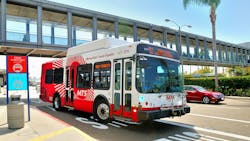Operators see increased pay at San Diego MTS, GoTriangle and CAT
Three transit providers across the United States have taken steps in increase pay for operators as the transit industry faces unprecedented recruitment challenges. The increase in wages is designed to attract and retain employees.
At the end of September, San Diego Metropolitan Transit System (MTS) bumped starting pay for bus operators more $2.00 per hour – from $20.21 to $22.71 – and indefinitely extended its $5,000 sign-on bonus for new hire bus operators. The agency explained tiered pay increases for existing bus operators will also be implemented to keep pace and provide an incentive to stay long-term with the agency.
“Like many businesses in the service sector, MTS is managing its way through a workforce shortage,” said MTS Chief Executive Officer Sharon Cooney. “Bus operator is one of the most important jobs at MTS. It’s also a very gratifying career path when you provide an essential service for so many people. These pay increases and sign-on bonuses serve as an incentive for those seeking a career path in transportation and help MTS continue operating a great system for our region.”
Pay increases and bonuses are part of MTS’ larger strategy to hire and retain frontline workers. The agency is recruiting for dozens of positions including trolley operators, electro-mechanics, station ambassadors, administrative positions, as well as bus operators.
GoTriangle in Durham, N.C., implemented a new pay policy that increases pay for new and existing employees. The new policy was developed with input from operators and maintenance staff, as well as management and includes all frontline employees.
GoTriangle formerly offered bus operators $17 an hour starting pay, with a percentage increase based on merit after years one, two and three. The new pay policy offers a starting pay of $19 an hour with a guaranteed rate of $20.38, $21.93 and $24.61 an hour, respectively after years one, two and three of employment. By the end of the fourth year and thereafter, a bus operator will receive a merit-based increase. Bus operators are also eligible for GoTriangle’s existing safety and customer service bonuses.
Service attendants will have a three-year guaranteed rate structure and merit pay after four years. Dispatchers, transit service supervisors, maintenance supervisors and mechanics will also see pay increases.
“The package is based on transparency and pay for performance and addresses compression issues so that all front-line operations staff – including operators, mechanics and service attendants – gain a pay increase relative to their seniority,” said GoTriangle President and CEO Charles Lattuca. “GoTriangle has been working hard to overcome this nationwide shortage of transit operators. In doing so, we've created a top-notch training program for those who want to start a career in operations but do not have a CDL license. Addressing compensation internally and externally, is another step towards our goal.”
Chatham Area Transit (CAT) in Savannah, Ga., has also increased pay for bus and paratransit operators. Fixed-route bus operators will not start at $20 and hour and paratransit operators will start at $15 an hour. CAT’s board approved the increase in pay ahead of an Oct. 28 job fair where the agency will be conducting onsite interviews.
Earlier this month, the American Public Transportation Association issued a report, Transit Workforce Shortage: Root Causes, Potential Solutions, and the Road Ahead, that found 96 percent of agencies surveyed reported experiencing a workforce shortage, 84 percent of which said the shortage is affecting their ability to provide service. Although the shortage is most acute at agencies serving large urbanized areas and agencies with greater ridership, most agencies across the country report the shortage has forced service reductions regardless of the size of an agency’s ridership, service area population or fleet.
The report suggested several actions agencies could take to attract and retain workers. These included an increase in compensation, improving worker schedules, creating a positive work environment, demonstrating a clear path to promotions or raises, ensuring worker safety, providing ongoing training, an increase in hiring practice effectiveness and an increase in recruiting practice effectiveness.

Mischa Wanek-Libman | Group Editorial Director
Mischa Wanek-Libman is director of communications with Transdev North America. She has more than 20 years of experience working in the transportation industry covering construction projects, engineering challenges, transit and rail operations and best practices.
Wanek-Libman has held top editorial positions at freight rail and public transportation business-to-business publications including as editor-in-chief and editorial director of Mass Transit from 2018-2024. She has been recognized for editorial excellence through her individual work, as well as for collaborative content.
She is an active member of the American Public Transportation Association's Marketing and Communications Committee and served 14 years as a Board Observer on the National Railroad Construction and Maintenance Association (NRC) Board of Directors.
She is a graduate of Drake University in Des Moines, Iowa, where she earned a Bachelor of Arts degree in Journalism and Mass Communication.








